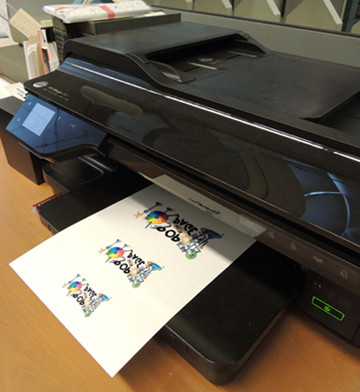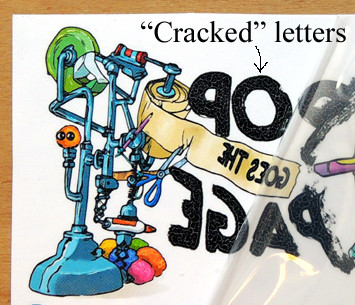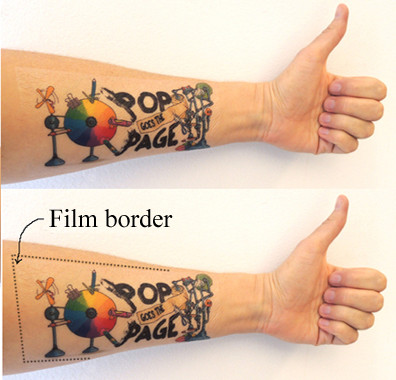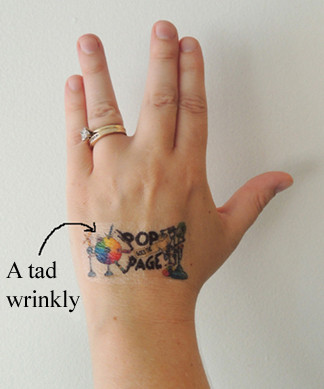How To Make Tattoo Paper? Tattoo paper allows you to temporarily showcase stunning designs without the commitment of permanent ink, and at tattooat.com, we’re passionate about providing you with creative and safe ways to express yourself through body art. Discover how to create your own custom temporary tattoos and explore a vast world of tattoo inspiration.
Here’s how to make tattoo paper, covering everything from selecting the right materials to applying your custom designs.
1. What is Tattoo Paper and Why Use It?
Tattoo paper is a specialized material that allows you to create temporary tattoos using a standard inkjet or laser printer. There are several reasons why people opt for tattoo paper:
- Experimentation: Test out tattoo designs and placements before committing to permanent ink.
- Events and Parties: Create fun, themed tattoos for parties, events, and costumes.
- Costumes: Use them for film, television, or even theatre.
- Personal Expression: Easily change your temporary tattoos to match your mood or style.
- Safety: Avoid the risks associated with permanent tattoos, such as infections or allergic reactions.
- Children’s Activities: Provide a safe and creative activity for kids’ parties or playtime.
2. What Materials Do You Need To Make Tattoo Paper?
To successfully create temporary tattoos, you’ll need the following materials:
| Material | Description |
|---|---|
| Tattoo Paper Kit | These kits typically include printable tattoo paper sheets and adhesive films. Brands like Silhouette, Papilio, and Sunnyscopa are popular choices. |
| Inkjet or Laser Printer | Most standard home printers will work, but ensure your printer is compatible with the tattoo paper. Laser printers generally produce more durable images. |
| Computer and Design Software | You’ll need a computer to design your tattoos. Software like Adobe Photoshop, GIMP, or even Microsoft Word can be used. |
| Scissors or Cutting Machine | To cut out your designs. A cutting machine like a Silhouette or Cricut provides more precise cuts, especially for intricate designs. |
| Application Tools | A clean, damp cloth or sponge to apply the tattoo to your skin. |
3. What Are The Steps To Creating Custom Temporary Tattoos?
Creating your own temporary tattoos is a fun and straightforward process. Here’s a step-by-step guide:
3.1. Design Your Tattoo
- Choose or Create Your Design: You can use existing images, create your own designs, or find inspiration online. Websites like Pinterest and Instagram are great resources for tattoo ideas. At tattooat.com, we have a huge variety of tattoo designs that can get you inspired.
- Mirror the Image: This is crucial, especially if your design includes text or has a specific orientation. The image will be reversed when applied to your skin, so you need to mirror it beforehand. Most photo editing software has a “flip horizontal” or “mirror” option.
- Size and Placement: Consider the size of your design and where you want to place the tattoo on your body. Make sure the design fits within the printable area of your tattoo paper.
3.2. Print Your Design
- Load the Tattoo Paper: Place the tattoo paper in your printer, ensuring you print on the correct side (usually the glossy side). Refer to your tattoo paper kit instructions for specific guidance.
- Print Settings: Adjust your printer settings for the best quality. Choose “photo quality” or a similar high-resolution setting.
- Print the Design: Print your mirrored design onto the tattoo paper. Allow the ink to dry completely before proceeding to the next step.
 Printing tattoo paper with an HP Officejet printer
Printing tattoo paper with an HP Officejet printer
3.3. Apply the Adhesive Sheet
- Peel and Apply: Most tattoo paper kits come with an adhesive sheet. Peel off the protective backing and carefully apply the adhesive to the printed side of the tattoo paper.
- Smooth Out Bubbles: Use a credit card or a similar flat object to smooth out any bubbles or wrinkles in the adhesive sheet. Ensure a firm, even adhesion.
 Cracked letters on tattoo paper due to printer incompatibility
Cracked letters on tattoo paper due to printer incompatibility
3.4. Cut Out Your Tattoo
- Cut the Design: Use scissors or a cutting machine to carefully cut out your tattoo design. If you want to minimize the visible film around the tattoo, cut as close to the edges of the design as possible.
- Prepare for Application: Once cut, your temporary tattoo is ready to be applied to your skin.
3.5. Apply the Tattoo to Your Skin
- Clean the Skin: Ensure the area of skin where you want to apply the tattoo is clean, dry, and free of oils or lotions.
- Peel Off the Adhesive Backing: Remove the clear plastic sheet from the adhesive side of the tattoo.
- Place the Tattoo: Position the tattoo face-down on your skin, pressing it firmly into place.
- Dampen the Backing: Take a damp cloth or sponge and press it firmly against the back of the tattoo paper. Hold for about 30-60 seconds, ensuring the paper is thoroughly wet.
- Remove the Paper: Gently peel away the paper backing. Your temporary tattoo should now be adhered to your skin.
- Let it Dry: Allow the tattoo to air dry for a few minutes. Avoid touching or stretching the area while it dries to ensure it adheres properly.
 Shoulder application of a temporary tattoo
Shoulder application of a temporary tattoo
4. What Are The Tips for Choosing the Right Tattoo Paper?
Selecting the right tattoo paper is crucial for achieving the best results. Here are some factors to consider:
- Printer Compatibility: Ensure the tattoo paper is compatible with your printer type (inkjet or laser).
- Water Resistance: Look for water-resistant tattoo paper to ensure your temporary tattoo lasts longer, even with light exposure to moisture.
- Skin Sensitivity: If you have sensitive skin, choose hypoallergenic tattoo paper to minimize the risk of irritation.
- Adhesive Quality: A good adhesive ensures the tattoo adheres well to the skin and provides a smooth, natural look.
- Durability: Check reviews and product descriptions to gauge the durability of the tattoo paper. Some papers are designed to last only a day, while others can last several days with proper care.
- Brand Reputation: Opt for reputable brands like Silhouette, Papilio, and Sunnyscopa, known for producing high-quality tattoo paper.
- Finish: Some tattoo papers come with a matte finish, while others have a glossy finish. Choose the finish that best suits your preferences and the design of your tattoo.
5. What Are The Common Issues and Troubleshooting?
Even with careful preparation, you might encounter some common issues when making and applying temporary tattoos. Here’s how to troubleshoot them:
| Issue | Possible Cause | Solution |
|---|---|---|
| Tattoo Not Adhering | Skin not clean, paper not wet enough, or poor-quality adhesive. | Ensure the skin is clean and dry before application. Use a thoroughly damp cloth or sponge and hold it firmly against the paper backing for the recommended time. If the adhesive is poor, try a different brand of tattoo paper. |
| Smudged or Blurry Print | Printer settings incorrect, ink not dry, or low-quality tattoo paper. | Adjust your printer settings to “photo quality” or a similar high-resolution setting. Allow the ink to dry completely before applying the adhesive sheet. Use high-quality tattoo paper designed for your printer type. |
| Visible Film Around Tattoo | Cutting too far from the edge of the design. | Use a cutting machine or carefully trim the tattoo as close to the edges of the design as possible. Some tattoo paper kits also include software that helps you create precise cut lines. |
| Tattoo Peeling or Cracking | Skin stretching, exposure to water, or low-quality tattoo paper. | Avoid stretching the skin where the tattoo is applied. Keep the tattoo dry and avoid prolonged exposure to water. Use high-quality, water-resistant tattoo paper. |
| Skin Irritation | Allergic reaction to the adhesive or ink. | Use hypoallergenic tattoo paper and test a small area of skin before applying the full tattoo. If irritation occurs, remove the tattoo immediately and wash the area with mild soap and water. |
| Residue Left on Skin | Adhesive residue remaining after removing the tattoo. | Use a cotton ball soaked in rubbing alcohol or baby oil to gently remove any residue. |
| Cracked Letters | Printer toner incompatibility. | Try using a color copier instead of an inkjet printer. |
6. What Are The Creative Ideas for Using Tattoo Paper?
Tattoo paper opens up a world of creative possibilities. Here are some ideas to get you started:
- Personalized Gifts: Create custom temporary tattoos for friends and family with their names, initials, or favorite designs.
- Promotional Items: Businesses can use temporary tattoos as promotional items at events or in marketing campaigns.
- Educational Tools: Teachers can use temporary tattoos to teach kids about history, science, or art.
- DIY Fashion Accessories: Design temporary tattoos to create unique patterns on clothing, shoes, or accessories.
- Holiday Themes: Create themed temporary tattoos for holidays like Halloween, Christmas, or St. Patrick’s Day.
- Cosplay: Enhance your cosplay costumes with intricate temporary tattoos that mimic the look of real tattoos.
 Forearm tattoo with dotted lines highlighting the film border
Forearm tattoo with dotted lines highlighting the film border
7. What Are The Safety Tips for Using Temporary Tattoos?
While temporary tattoos are generally safe, it’s important to take certain precautions:
- Use Hypoallergenic Paper: Choose tattoo paper specifically designed for sensitive skin to minimize the risk of allergic reactions.
- Test a Small Area: Before applying a large tattoo, test a small area of skin to ensure you don’t have an adverse reaction.
- Avoid Sensitive Areas: Do not apply temporary tattoos to sensitive areas like the eyes, mouth, or broken skin.
- Remove Immediately if Irritated: If you experience any redness, itching, or swelling, remove the tattoo immediately and wash the area with mild soap and water.
- Supervise Children: When using temporary tattoos with children, supervise them to ensure they do not ingest the paper or adhesive.
- Check Ingredients: Be aware of the ingredients in the tattoo paper and adhesive. Avoid products containing harmful chemicals or allergens.
- Limit Wear Time: Do not wear temporary tattoos for extended periods. Remove them after a day or two to allow your skin to breathe.
8. How Long Do Temporary Tattoos Last?
The longevity of a temporary tattoo depends on several factors:
- Tattoo Paper Quality: High-quality tattoo paper with a strong adhesive will generally last longer.
- Skin Type: Oily skin may cause the tattoo to fade more quickly than dry skin.
- Placement: Tattoos placed on areas that experience a lot of friction (e.g., hands, wrists) may wear off faster.
- Care: Proper care, such as avoiding excessive washing and friction, can prolong the life of the tattoo.
Generally, temporary tattoos made with tattoo paper can last anywhere from 1 to 5 days.
 Hand tattoo showing potential wrinkling of the film
Hand tattoo showing potential wrinkling of the film
9. How Do You Remove Temporary Tattoos?
Removing temporary tattoos is usually simple and painless. Here are a few methods:
- Soap and Water: Gently wash the area with mild soap and warm water. Use a soft cloth or sponge to scrub away the tattoo.
- Rubbing Alcohol: Apply rubbing alcohol to a cotton ball and gently rub the tattoo until it comes off.
- Baby Oil or Olive Oil: Apply baby oil or olive oil to the tattoo and let it sit for a few minutes. Then, gently rub the tattoo with a cloth or sponge until it comes off.
- Makeup Remover: Use a gentle makeup remover to dissolve the adhesive and ink.
- Adhesive Tape: Place a piece of adhesive tape over the tattoo and press firmly. Then, quickly peel off the tape, which should remove the tattoo.
10. Where Can You Find Inspiration for Tattoo Designs?
Finding the perfect tattoo design can be an exciting journey. Here are some resources for inspiration:
- Online Tattoo Galleries: Websites like tattooat.com, Pinterest, and Instagram host a vast collection of tattoo designs in various styles and themes.
- Tattoo Artists’ Portfolios: Browse the portfolios of tattoo artists to see their work and get ideas for your own custom design.
- Tattoo Magazines: Magazines like Inked Magazine and Tattoo Life showcase the latest trends in tattoo art and feature interviews with renowned artists.
- Art Books: Explore art books on various subjects, such as mythology, nature, and history, for unique and meaningful tattoo ideas.
- Personal Interests: Draw inspiration from your own hobbies, passions, and experiences.
- Cultural Symbols: Research cultural symbols and motifs that resonate with you and incorporate them into your tattoo design.
- Nature: Nature is one of the most inspiring things for tattoo designs, with different designs of landscapes, animals, botanicals, or celestial patterns.
- Pop Culture: Anything from fictional characters, quotes, and logos from movies, video games, and TV Shows could make for a great tattoo design.
FAQ: Making Tattoo Paper
| Question | Answer |
|---|---|
| Can I use any printer for tattoo paper? | While most inkjet or laser printers are compatible, it’s crucial to check the tattoo paper’s specifications to ensure it matches your printer type for optimal results. |
| Do I need special ink for tattoo paper? | No, standard printer ink is generally suitable for tattoo paper, but using high-quality ink can enhance the vibrancy and longevity of your temporary tattoos. |
| How do I prevent smudging when printing? | Ensure your printer settings are set to “photo quality” or a similar high-resolution option, and allow the ink to dry completely before handling the printed tattoo paper to prevent smudging. |
| Is tattoo paper safe for all skin types? | While most tattoo paper is safe, individuals with sensitive skin should opt for hypoallergenic options and perform a patch test before applying a large tattoo to avoid potential allergic reactions. |
| How long does a temporary tattoo last? | The lifespan of a temporary tattoo varies depending on factors like skin type, placement, and care, but generally, they last from 1 to 5 days with proper maintenance. |
| Can I reuse tattoo paper? | No, tattoo paper is designed for single-use applications, as the adhesive and printing layers are consumed during the transfer process, rendering it ineffective for subsequent uses. |
| How do I remove a temporary tattoo easily? | You can easily remove a temporary tattoo by gently scrubbing the area with mild soap and warm water, or by using rubbing alcohol, baby oil, or makeup remover to dissolve the adhesive. |
| Can I swim with a temporary tattoo? | While some tattoo paper is water-resistant, prolonged exposure to water can cause the tattoo to fade or peel off, so it’s best to avoid swimming or excessive water contact to prolong its lifespan. |
| How do I store tattoo paper properly? | To maintain the quality and effectiveness of tattoo paper, store it in a cool, dry place away from direct sunlight and moisture, and keep it sealed in its original packaging until ready to use. |
| Can I create multi-colored tattoos? | Yes, you can create multi-colored tattoos by designing your image with various colors and ensuring your printer is capable of printing in color to accurately reproduce your design on the tattoo paper. |
Creating your own tattoo paper is a fun and creative way to explore the world of tattoos without the commitment. Whether you’re experimenting with designs, creating custom accessories, or planning a themed event, tattoo paper offers endless possibilities.
Ready to bring your tattoo ideas to life? Visit tattooat.com for inspiration, design resources, and a curated list of talented tattoo artists across the USA.
Address: 1825 SW Broadway, Portland, OR 97201, United States
Phone: +1 (503) 725-3000
Website: tattooat.com
Discover your next masterpiece today.

